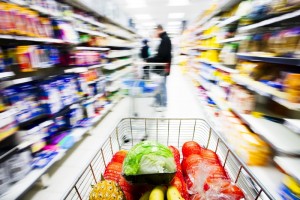In the past, the supermarket wars were fought on location and floor space. The biggest supermarkets had the most space in the best locations. Today it’s very different as battles are won and lost on price, loyalty and maintaining profit margins.
The price of milk rose to the top of the headlines recently, with some supermarkets reportedly lowering their price to the detriment of their suppliers. Politics aside, the reason supermarkets are tempted to lower prices is to attract and keep customers. If the milk is a good price, what else might a customer buy during the same shopping trip?
 The rise of discount stores is seemingly a sign that customers prioritise price over range. Aldi, for example, has roughly 3,000 different products in its stores, significantly less than its UK competitors that can have around seven to 10 times more. But the milk debate and subsequent consumer commentary revealed that though customers have been voting for discounts with their pennies, their heads tell them that they wouldn’t really mind paying more. It’s about perceived price and value, rather than actual price.
The rise of discount stores is seemingly a sign that customers prioritise price over range. Aldi, for example, has roughly 3,000 different products in its stores, significantly less than its UK competitors that can have around seven to 10 times more. But the milk debate and subsequent consumer commentary revealed that though customers have been voting for discounts with their pennies, their heads tell them that they wouldn’t really mind paying more. It’s about perceived price and value, rather than actual price.
This is no small issue. Earlier this year it was reported that the ‘entire structure’ of the supermarket landscape has changed because of the price war. Discount supermarkets are picking up more and more market share - Aldi now has 5.6 per cent, Lidl 4.1 per cent (a combined 9.6 per cent), pushing Waitrose down to seventh place with 5.1 per cent. This leaves a conundrum for non-discount supermarkets in which price must remain a priority, but where loyalty and range are also factors.
New games, new rules
Today’s battlegrounds are knowledge of customer preferences and behaviours and creating and keeping loyalty. The supermarket that knows its customers best can create a price point and a range that best suits them. That could even be at the hyper-local level too as high street space is at a premium and therefore must be used wisely.
At what cost? The major focus for traditional grocers has to be the ‘cost to sell’. The discounters are celebrated for their lean low cost structure, which from my vantage point is a world away from the likes of Tesco, Sainsbury’s and Morrisons. New inventive ways to retain market share are actually increasing the cost of doing business – e.g. Click & Collect. In fact, John Lewis announced recently it was now charging for this service.
Insights from real-time analysis can lead to better decisions on range. Knowing what your customers want can provide lots of useful insights for purchasing managers to decide which products to stock and at which store location, and most importantly, factoring in visibility over cost of sales and ensuring a focus on remaining profitable.
The traditional ‘points means prizes’ approach is no longer sufficient to retain customer loyalty. Instead, ask yourself this: what can you do to give them greater control over how they are rewarded; what are their shopping pain points and how can you evolve your business model to will keep them coming back for more?
Supermarket wars are no longer simply about location, floor space, or even price. It’s now data-driven and loyalty-focused, and the battles are being waged with customer knowledge and analytics.
To find out more, we worked with Northwestern University's Kellogg School of Management to explore what drives consumer loyalty. The results and recommendations are summarised in Shopper Insights to Improve Retail Loyalty Programs - download the report to learn more about what matters most to consumers with respect to loyalty, views about retail industry role models with respect to loyalty, and more.
